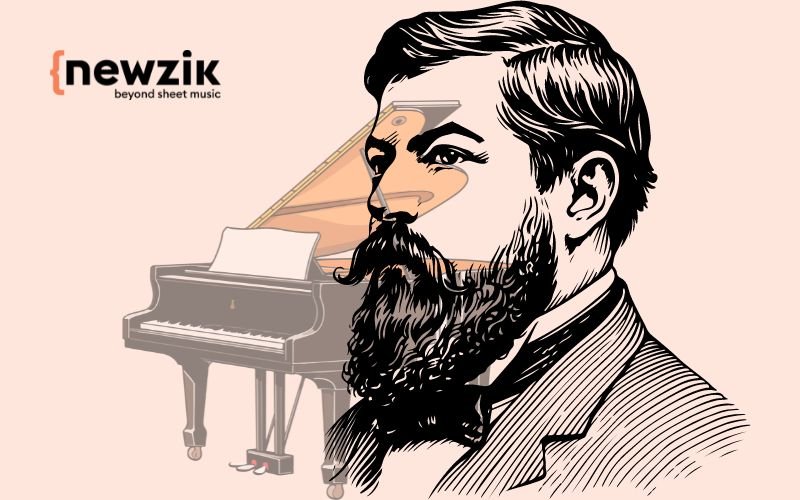PROFILE - Claude Debussy (1862 - 1918)
Claude Debussy, an innovative composer at the turn of the 20th century, revolutionized classical music with his quest for freedom and his unique approach to harmony. Rejecting established conventions, he gave birth to a new musical language, often referred to as Impressionist, although Debussy himself never adopted this term. His free style has influenced many artists of modern music. But how did the career of this extraordinary musician develop? What works marked his era, both for orchestra and piano? Newzik takes a look back at the life of the master of musical impressionism.
An atypical early training
Born on August 22, 1862 in Saint-Germain-en-Laye, Claude Debussy grew up in a modest family. His mother, Victorine, was a seamstress and decided to educate him herself at home, refusing to let him attend school. His father, Manuel-Achille Debussy, was imprisoned for supporting the revolutionaries during the Paris Commune. At the age of 8, Debussy began piano lessons with his aunt. From an early age, he developed a special bond with music.
His entry into the Paris Conservatoire at the age of 10 marked the beginning of his musical training, although he did not follow a traditional path. He quickly distinguished himself by his ability to think about music in unconventional ways, inspired not only by his teachers but also by literary and philosophical readings. Symbolist poets and the works of composers such as Wagner and Chopin strongly influenced his artistic development.
Italy, a turning point in the French composer's career
In 1884, Claude Debussy won the Prix de Rome for his cantata L'Enfant prodigue, which enabled him to stay at the Villa Medici. It was during this period in Italy that he began to refine his musical language, breaking away from the rigid forms and structures taught at the Conservatoire. The creative freedom he encountered in Italy laid the foundations for his future aesthetic, marked by the use of new scales and a rejection of conventional harmonies.
Debussy: an innovative, avant-garde musical style
Debussy quickly distinguished himself by his singular approach to music. His style broke with academic rules, favoring the exploration of timbres and harmonies over traditional forms. He abandons classical symphonic constructions in favor of freer evocations of sound, inspired in particular by the visual arts. His compositions convey emotions and impressions, like the Impressionist movement in painting, although he has never claimed to be an Impressionist.
In the 1890s, Debussy began to make a name for himself with works such as Prélude à l'après-midi d'un faune (1894). This piece, inspired by a poem by Mallarmé, reveals his mastery of subtle orchestration and musical atmosphere. It quickly won acclaim for its innovative character, and opened a new chapter in thehistory of orchestralmusic. This success established Debussy as a key figure on the European musical landscape.
The impact of art and literature on Debussy's work
Claude Debussy was profoundly influenced by the visual arts and literature. His proximity to the Symbolist and Impressionist movements nourished his approach to composition. He particularly admired poets such as Mallarmé and Verlaine, as well as Impressionist painters like Monet and Whistler. These literary and artistic influences are reflected in his evocative compositions, in which impressions and nuances are brought to the fore.
Oriental influences in Debussy's music
Debussy also drew on non-European music, notably at the 1889 World's Fair in Paris, where he discovered the sounds of the Javanese gamelan. This non-Western music influenced his treatment of scales and rhythms, resulting in ever greater freedom in his music.
Debussy and social criticism in music
Debussy was not only a composer, he also had strong opinions about the society and musical culture of his time. He fiercely rejected the conventions of the academic music of the day. His refusal to conform to the expectations of audiences and critics made him a true musical rebel, constantly seeking to renew and reinvent the art of music.
🎶 3 anecdotes about Claude Debussy
The French composer was particularly attached to his Bechstein piano, which he regarded not just as an instrument, but as a veritable extension of his creative spirit. This instrument accompanied him in most of his compositions.
The Académie des Beaux-Arts took a dim view of Claude Debussy's innovative approach, deeming his work too singular and out of step with the standards of the time.
An asteroid bears his name: asteroid (4492) Debussy, and a crater on Mercury was also named "Debussy" in 2010 as a tribute to the composer.
Claude Debussy's masterpieces
Pelléas et Mélisande: an extraordinary opera
One of Debussy's landmark works is undoubtedly his opera Pelléas et Mélisande, premiered in 1902. Unlike traditional Romantic operas, Debussy opted for music dominated by subtle nuances, emphasizing dialogue and atmosphere rather than grand arias. The result is a work of profound sensitivity, where every note seems to whisper the emotions of the characters. Debussy was particularly innovative in his use of the voice, with dialogues sung in an almost spoken form, breaking with the lyrical conventions of the time.
La Mer: a musical painting of the ocean
In 1905, Debussy composed La Mer, an orchestral work that evokes the movements and mysteries of deep water. Far from literal descriptions, this piece is a sonic translation of the sensations provoked by the sea, with harmonic waves and sonic textures that reflect the immensity and fluidity of the water. Debussy is renowned for his innovative use of the orchestra. He treats the orchestra as a palette of colors, playing on nuances and timbres to create subtle, evocative sound effects. His approach influenced many composers after him.
Suite Bergamasque and the famous Clair de Lune
Among Debussy's piano works, the Suite Bergamasque stands out in particular for its third movement, Clair de Lune. This piece has become one of the most famous in the piano repertoire, renowned for its gentle, dreamlike atmosphere. Through these pieces, Debussy demonstrates his fluid, unpredictable approach to melody, and creates musical moods that leave room for the listener's imagination.
Preludes and Images: musical tableaux
In his piano cycles, such as Préludes and Images, Debussy continues to explore the harmonic and rhythmic possibilities of his instrument. Each of these pieces evokes a scene, a landscape or an emotion, turning the listener into a sensory traveler. The melodic freedom in these works reflects his rejection of convention.
Vocal works: poetry set to music
Debussy also excelled in composing for solo voice. One of his earliest vocal works, Nuit d'étoiles (1880), written to a poem by Théodore de Banville, already reveals his ability to combine poetry with delicate melody. This melody for voice and piano is an example of Debussy's use of the voice, where the music sublimates the poetic images and emotions in the work.
A few years later, in Nocturnes (1899), and particularly in the Sirènes movement, Debussy explored another dimension of the voice by integrating a women's choir. Here, voices are no longer used to tell a story, but to enrich the musical texture.
The legacy of Claude Debussy
Debussy's last years: a battle against illness
In his last years, Debussy suffered from cancer, which gradually weakened him. Despite his illness, he continued to compose, but his late works reveal a certain melancholy. His last major composition, The Sonata for Flute, Viola and Harp (1915), is an example of his struggle against pain and his desire to continue innovating until the end. This sonata is both light-hearted and tragic, symbolizing both his musical genius and his declining health.
Claude Debussy died on March 25, 1918 in Paris, leaving behind works that profoundly transformed classical music. He marked the end of the Romantic era and paved the way for the musical revolutions to come.
Debussy's influence on jazz and contemporary music
Although Debussy is primarily associated with classical music, his influence extends far beyond. Many jazz musicians, including Bill Evans and Duke Ellington, were fascinated by his use of harmony and complex chord progressions. His music, full of subtlety and innovation, has inspired generations of modern composers such as Olivier Messiaen and Pierre Boulez, who have incorporated aspects of his harmonic language into their own avant-garde works.
Compositions and highlights of Claude Debussy's life
August 22, 1862: Birth of Claude Debussy in Saint-Germain-en-Laye, France.
1872: Entry into the Paris Conservatoire at the age of 10.
1884: Wins the Prix de Rome with the cantata L'Enfant prodigue.
1894: Premiere of Prélude à l'après-midi d'un faune, a work emblematic of his style.
1902: Premiere of the opera Pelléas et Mélisande.
1905: Composition of La Mer, a symphonic masterpiece.
1910-1913: Writing of Préludes, two books of piano pieces.
1915: Composition of a last major orchestral work, Sonata for flute, viola and harp.
March 25, 1918: Claude Debussy dies in Paris, aged 55
🎶 Want to explore more of Claude Debussy's musical universe? Vibrate to rythm his works with the Newzik sheet music player. Annotations, real-time sharing, access to your scores wherever you are, and even a collaborative platform for orchestra - Newzik offers you a new way of experiencing music. Try it now for free!







